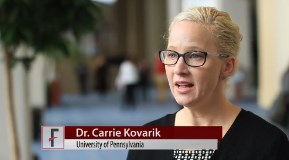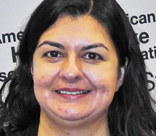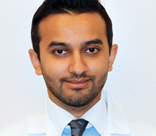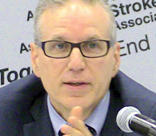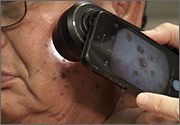User login
VIDEO: Expert – Skin signs to watch for in HIV patients
WASHINGTON – While the widespread use of antiretroviral therapy in the United States has markedly reduced the prevalence of cutaneous manifestations of HIV and AIDS, dermatologists still may see patients who present with cutaneous manifestations of undiagnosed infections, including aggressive human papillomavirus infections, according to Dr. Carrie L. Kovarik.
Dr. Kovarik of the department of dermatology, University of Pennsylvania, Philadelphia, recommended seeing these patients more frequently – perhaps every month or 2 – to monitor HPV infection and genital warts. Even in patients who now have more robust immune systems, those who were once immunocompromised are at risk of malignant generation of their genital warts.
Dr. Kovarik discusses that, as well as hypersensitivity reactions to some HIV and tuberculosis treatments, in an interview at the annual meeting of the American Academy of Dermatology.
The video associated with this article is no longer available on this site. Please view all of our videos on the MDedge YouTube channel
On Twitter @denisefulton
WASHINGTON – While the widespread use of antiretroviral therapy in the United States has markedly reduced the prevalence of cutaneous manifestations of HIV and AIDS, dermatologists still may see patients who present with cutaneous manifestations of undiagnosed infections, including aggressive human papillomavirus infections, according to Dr. Carrie L. Kovarik.
Dr. Kovarik of the department of dermatology, University of Pennsylvania, Philadelphia, recommended seeing these patients more frequently – perhaps every month or 2 – to monitor HPV infection and genital warts. Even in patients who now have more robust immune systems, those who were once immunocompromised are at risk of malignant generation of their genital warts.
Dr. Kovarik discusses that, as well as hypersensitivity reactions to some HIV and tuberculosis treatments, in an interview at the annual meeting of the American Academy of Dermatology.
The video associated with this article is no longer available on this site. Please view all of our videos on the MDedge YouTube channel
On Twitter @denisefulton
WASHINGTON – While the widespread use of antiretroviral therapy in the United States has markedly reduced the prevalence of cutaneous manifestations of HIV and AIDS, dermatologists still may see patients who present with cutaneous manifestations of undiagnosed infections, including aggressive human papillomavirus infections, according to Dr. Carrie L. Kovarik.
Dr. Kovarik of the department of dermatology, University of Pennsylvania, Philadelphia, recommended seeing these patients more frequently – perhaps every month or 2 – to monitor HPV infection and genital warts. Even in patients who now have more robust immune systems, those who were once immunocompromised are at risk of malignant generation of their genital warts.
Dr. Kovarik discusses that, as well as hypersensitivity reactions to some HIV and tuberculosis treatments, in an interview at the annual meeting of the American Academy of Dermatology.
The video associated with this article is no longer available on this site. Please view all of our videos on the MDedge YouTube channel
On Twitter @denisefulton
AT AAD 16
Uncontrolled hidradenitis suppurativa costs the health care system
WASHINGTON – One in four hidradenitis suppurativa patients saw their disease become more severe, requiring significantly more health care resources and driving up health care spending.
Dr. Alexa Boer Kimball, professor of dermatology at Harvard Medical School, Boston, and her colleagues reviewed commercial claims in the OptumHealth Reporting and Insights Database from 1998 through early 2014, identifying 1,314 adult patients treated for hidradenitis suppurativa (HS). About a quarter of these patients (323) experienced an increase in the severity of their disease, represented by an inpatient or emergency department visit or skin surgery performed on the same day as a dermatologic diagnosis. Their findings were presented at the annual meeting of the American Academy of Dermatology.
“Patients with hidradenitis suppurativa use a substantial level of health care resources, especially given their relatively young age,” Dr. Kimball said in an interview. “The results of this study suggest that if we can implement effective therapies that prevent patients from progressive disease, we may not only be able to improve their outcomes but also meaningfully reduce costs to the health care system.”
Patients who progressed to a more severe form of HS had significantly more outpatient visits (incidence rate ratio, 1.35), as well as inpatient visits (IRR, 2.48), emergency department visits (IRR, 1.71), and other medical service visits (IRR, 1.81), compared with those whose disease did not progress (all, P less than .001).
The most common indicators of disease progression included skin surgery (62%) and the initiation of a strong pain reliever (34%), Dr. Kimball noted.
Health care costs for patients whose disease progressed was $5,052 higher than were costs for those whose disease did not progress. Cost increases were driven mainly by higher outpatient costs and high inpatient costs (for both, P less than .05). Differences in pharmacy costs were not statistically significant.
“To date, no guidelines are available in the United States for the management of hidradenitis suppurativa and, until very recently, there was no treatment approved in the U.S.,” Dr. Kimball and her colleagues said.
Adalimumab gained Food and Drug Administration approval for moderate to severe HS in 2015.
On Twitter @denisefulton
WASHINGTON – One in four hidradenitis suppurativa patients saw their disease become more severe, requiring significantly more health care resources and driving up health care spending.
Dr. Alexa Boer Kimball, professor of dermatology at Harvard Medical School, Boston, and her colleagues reviewed commercial claims in the OptumHealth Reporting and Insights Database from 1998 through early 2014, identifying 1,314 adult patients treated for hidradenitis suppurativa (HS). About a quarter of these patients (323) experienced an increase in the severity of their disease, represented by an inpatient or emergency department visit or skin surgery performed on the same day as a dermatologic diagnosis. Their findings were presented at the annual meeting of the American Academy of Dermatology.
“Patients with hidradenitis suppurativa use a substantial level of health care resources, especially given their relatively young age,” Dr. Kimball said in an interview. “The results of this study suggest that if we can implement effective therapies that prevent patients from progressive disease, we may not only be able to improve their outcomes but also meaningfully reduce costs to the health care system.”
Patients who progressed to a more severe form of HS had significantly more outpatient visits (incidence rate ratio, 1.35), as well as inpatient visits (IRR, 2.48), emergency department visits (IRR, 1.71), and other medical service visits (IRR, 1.81), compared with those whose disease did not progress (all, P less than .001).
The most common indicators of disease progression included skin surgery (62%) and the initiation of a strong pain reliever (34%), Dr. Kimball noted.
Health care costs for patients whose disease progressed was $5,052 higher than were costs for those whose disease did not progress. Cost increases were driven mainly by higher outpatient costs and high inpatient costs (for both, P less than .05). Differences in pharmacy costs were not statistically significant.
“To date, no guidelines are available in the United States for the management of hidradenitis suppurativa and, until very recently, there was no treatment approved in the U.S.,” Dr. Kimball and her colleagues said.
Adalimumab gained Food and Drug Administration approval for moderate to severe HS in 2015.
On Twitter @denisefulton
WASHINGTON – One in four hidradenitis suppurativa patients saw their disease become more severe, requiring significantly more health care resources and driving up health care spending.
Dr. Alexa Boer Kimball, professor of dermatology at Harvard Medical School, Boston, and her colleagues reviewed commercial claims in the OptumHealth Reporting and Insights Database from 1998 through early 2014, identifying 1,314 adult patients treated for hidradenitis suppurativa (HS). About a quarter of these patients (323) experienced an increase in the severity of their disease, represented by an inpatient or emergency department visit or skin surgery performed on the same day as a dermatologic diagnosis. Their findings were presented at the annual meeting of the American Academy of Dermatology.
“Patients with hidradenitis suppurativa use a substantial level of health care resources, especially given their relatively young age,” Dr. Kimball said in an interview. “The results of this study suggest that if we can implement effective therapies that prevent patients from progressive disease, we may not only be able to improve their outcomes but also meaningfully reduce costs to the health care system.”
Patients who progressed to a more severe form of HS had significantly more outpatient visits (incidence rate ratio, 1.35), as well as inpatient visits (IRR, 2.48), emergency department visits (IRR, 1.71), and other medical service visits (IRR, 1.81), compared with those whose disease did not progress (all, P less than .001).
The most common indicators of disease progression included skin surgery (62%) and the initiation of a strong pain reliever (34%), Dr. Kimball noted.
Health care costs for patients whose disease progressed was $5,052 higher than were costs for those whose disease did not progress. Cost increases were driven mainly by higher outpatient costs and high inpatient costs (for both, P less than .05). Differences in pharmacy costs were not statistically significant.
“To date, no guidelines are available in the United States for the management of hidradenitis suppurativa and, until very recently, there was no treatment approved in the U.S.,” Dr. Kimball and her colleagues said.
Adalimumab gained Food and Drug Administration approval for moderate to severe HS in 2015.
On Twitter @denisefulton
AT AAD 2016
Key clinical point: Effective therapies that prevent patients with hidradenitis suppurativa from progressive disease may improve outcomes while reducing health care costs.
Major finding: Costs for patients whose HS progressed was $5,052 higher than those whose disease did not.
Data source: Review of commercial claims database identifying 1,314 adults with HS.
Disclosures: The study was supported by AbbVie. Dr. Kimball disclosed financial relationships with AbbVie, Janssen, Novartis, and Amgen, and one of her colleagues is an AbbVie employee.
VIDEO: The New Gastroenterologist offers insights, lifestyle info for young specialists
PHILADELPHIA – Are there things you wish you’d learned as a gastroenterology fellow? How to build a reputation as a good speaker, how to grow a successful clinical practice, and even how to choose the best retirement fund options for your personal goals are the kinds of tips and insights you’ll find in The New Gastroenterologist.
The newest publication from the American Gastroenterological Association, The New Gastroenterologist offers practical clinical information, lifestyle features, interviews with leaders in the field, and details on where to find research funding.
“Our goal is to provide unique content that speaks to all the needs that young gastroenterologists have, and to have it all in one place,” says The New Gastroenterologist Editor-in-Chief Dr. Bryson Katona.
The video associated with this article is no longer available on this site. Please view all of our videos on the MDedge YouTube channel
On Twitter @whitneymcknight
PHILADELPHIA – Are there things you wish you’d learned as a gastroenterology fellow? How to build a reputation as a good speaker, how to grow a successful clinical practice, and even how to choose the best retirement fund options for your personal goals are the kinds of tips and insights you’ll find in The New Gastroenterologist.
The newest publication from the American Gastroenterological Association, The New Gastroenterologist offers practical clinical information, lifestyle features, interviews with leaders in the field, and details on where to find research funding.
“Our goal is to provide unique content that speaks to all the needs that young gastroenterologists have, and to have it all in one place,” says The New Gastroenterologist Editor-in-Chief Dr. Bryson Katona.
The video associated with this article is no longer available on this site. Please view all of our videos on the MDedge YouTube channel
On Twitter @whitneymcknight
PHILADELPHIA – Are there things you wish you’d learned as a gastroenterology fellow? How to build a reputation as a good speaker, how to grow a successful clinical practice, and even how to choose the best retirement fund options for your personal goals are the kinds of tips and insights you’ll find in The New Gastroenterologist.
The newest publication from the American Gastroenterological Association, The New Gastroenterologist offers practical clinical information, lifestyle features, interviews with leaders in the field, and details on where to find research funding.
“Our goal is to provide unique content that speaks to all the needs that young gastroenterologists have, and to have it all in one place,” says The New Gastroenterologist Editor-in-Chief Dr. Bryson Katona.
The video associated with this article is no longer available on this site. Please view all of our videos on the MDedge YouTube channel
On Twitter @whitneymcknight
VIDEO: What are physicians’ top legal risks in 2016?
AUSTIN, TEX. – With ongoing changes in health delivery and ever-increasing government scrutiny over care, physicians face a number of pressing legal risks this year.
At an American Health Lawyers Association meeting, Birmingham, Ala., health law attorney William W. Horton shared the top legal dangers for doctors in 2016.
From False Claims Act investigations and whistle-blower claims to liability connected to value-based care, clinicians have a lot to consider, said Mr. Horton, who is chair of the American Bar Association Health Law Section.
In a video interview, Mr. Horton also discussed how to reduce liability and limit government inquiries.
On Twitter @legal_med
AUSTIN, TEX. – With ongoing changes in health delivery and ever-increasing government scrutiny over care, physicians face a number of pressing legal risks this year.
At an American Health Lawyers Association meeting, Birmingham, Ala., health law attorney William W. Horton shared the top legal dangers for doctors in 2016.
From False Claims Act investigations and whistle-blower claims to liability connected to value-based care, clinicians have a lot to consider, said Mr. Horton, who is chair of the American Bar Association Health Law Section.
In a video interview, Mr. Horton also discussed how to reduce liability and limit government inquiries.
On Twitter @legal_med
AUSTIN, TEX. – With ongoing changes in health delivery and ever-increasing government scrutiny over care, physicians face a number of pressing legal risks this year.
At an American Health Lawyers Association meeting, Birmingham, Ala., health law attorney William W. Horton shared the top legal dangers for doctors in 2016.
From False Claims Act investigations and whistle-blower claims to liability connected to value-based care, clinicians have a lot to consider, said Mr. Horton, who is chair of the American Bar Association Health Law Section.
In a video interview, Mr. Horton also discussed how to reduce liability and limit government inquiries.
On Twitter @legal_med
EXPERT ANALYSIS FROM THE PHYSICIANS AND HOSPITALS LAW INSTITUTE
Webcast: Factors that contribute to overall contraceptive efficacy and risks
The video associated with this article is no longer available on this site. Please view all of our videos on the MDedge YouTube channel
Access Dr. Burkman's Webcasts on contraception:
- Obesity and contraceptive efficacy and risks
- How to use the CDC's online tools to manage complex cases in contraception
Helpful resource for your practice:
The video associated with this article is no longer available on this site. Please view all of our videos on the MDedge YouTube channel
Access Dr. Burkman's Webcasts on contraception:
- Obesity and contraceptive efficacy and risks
- How to use the CDC's online tools to manage complex cases in contraception
Helpful resource for your practice:
The video associated with this article is no longer available on this site. Please view all of our videos on the MDedge YouTube channel
Access Dr. Burkman's Webcasts on contraception:
- Obesity and contraceptive efficacy and risks
- How to use the CDC's online tools to manage complex cases in contraception
Helpful resource for your practice:
Pooja Khatri, MD
The video associated with this article is no longer available on this site. Please view all of our videos on the MDedge YouTube channel
The video associated with this article is no longer available on this site. Please view all of our videos on the MDedge YouTube channel
The video associated with this article is no longer available on this site. Please view all of our videos on the MDedge YouTube channel
Haseeb Rahman, MD
The video associated with this article is no longer available on this site. Please view all of our videos on the MDedge YouTube channel
The video associated with this article is no longer available on this site. Please view all of our videos on the MDedge YouTube channel
The video associated with this article is no longer available on this site. Please view all of our videos on the MDedge YouTube channel
Lee Schwamm, MD
The video associated with this article is no longer available on this site. Please view all of our videos on the MDedge YouTube channel
The video associated with this article is no longer available on this site. Please view all of our videos on the MDedge YouTube channel
The video associated with this article is no longer available on this site. Please view all of our videos on the MDedge YouTube channel
VIDEO: Hands-off yields best brain arteriovenous malformation outcomes
LOS ANGELES – Hang a do-not-disturb sign on brain arteriovenous malformations.
Patients who underwent invasive interventions to repair an unruptured arteriovenous malformation (AVM) in their brain faced a greater than two-fold increased rate of death or stroke during an average 4 years of follow-up, compared with patients who received medical treatment only with no active intervention, Dr. Christian Stapf reported at the International Stroke Conference.
When analyzed on an intention-to-treat basis, for every five AVM patients treated by endovascular surgery, conventional surgery, or radiotherapy, one additional patient died or had a stroke, compared with the death or stroke rate among control patients who received only medical management. When analyzed based on the treatments that patients actually received, the number-needed-to-harm fell to one excess death or stroke for every three AVM patients who underwent an invasive procedure, compared with control patients, reported Dr. Stapf, a professor in the department of neurosciences at the University of Montreal.
The results from A Randomized Trial of Unruptured Brain AVMs (ARUBA) “show us that we clearly have not been as good as we thought in helping patients against their stroke risk,” said Dr. Stapf in a video interview during the meeting. “Given that the risk of death or stroke was reduced three- to fivefold with no [invasive] treatment and leaving the AVM alone makes us think that we can’t recommend preventive intervention with currently-used techniques. Living with the AVM seems like the far better option.”
The ARUBA study, run at 39 centers in nine countries including 13 U.S. centers, randomized 226 patients with unruptured AVMs before the study’s data safety and monitoring board stopped study enrollment prematurely in April 2013. The study group included 110 patients randomized to receive medical interventions only and 116 randomized to medical intervention plus “best possible” AVM eradication. The exact type of eradication for each patient was left up to local clinicians, who tailored the intervention to address the size, location, and anatomy of each AVM. Medical management included steps such as treatment with antiepileptic drugs to treat seizures, various treatments for headaches, and physiotherapy for patients with neurologic deficits.
The study’s primary endpoint was the combined rate of death or stroke, which occurred in 41 of the 116 patients (35%) randomized to receive an invasive intervention and in 15 of the 110 (14%) randomized to medical treatment only during an average follow-up of 50 months, with many patients followed for 5 years.
When analyzed by the treatment patients actually received, 106 underwent an invasive intervention and 43 of these patients (41%) died or had a stroke, and 120 patients received medical treatments only, of whom 13 (11%) died or had a stroke.
A secondary endpoint was the rate of death or disability after 5-year follow-up, with disability defined as a modified Rankin Scale score of 2 or more. This occurred in 38% of the 45 patients who underwent AVM eradication and had this follow-up available, and in 18% of 51 patients who had medial treatment only and received this follow-up.
Interim results from the study came out 2 years ago, with an average follow-up of 33 months (Lancet. 2014 Feb 15;383[9917]:614-21), but the trial was designed to have 5-year follow-up, largely accomplished in the new data reported by Dr. Stapf.
Many clinicians had already abandoned invasive interventions to treat brain AVMs following release of the interim results, and Dr. Stapf predicted that this trend will further strengthen now that the final results are in and confirm the earlier indication of hazard. Until the ARUBA results became available, clinicians had presumed invasive interventions to resolve or minimize malformations were beneficial based on intuition. ARUBA is the first systematic comparison of procedures versus a hands-off approach for brain AVMs, he said.
“Neurologists will now be less likely to refer patients for intervention, and interventionalists will be less enthusiastic to perform procedures,” Dr. Stapf said during the meeting, sponsored by the American Heart Association. In addition, anyone now performing an intervention in routine practice would need to consider the possible legal implications if the patient were to have a bad outcome. Dr. Stapf also noted that some professional societies are now considering recommendations against routine interventions. He conceded that some invasive interventions might still occur for selected cases on an investigational basis, but the ARUBA results “set the bar very high against performing any new interventions,” he concluded.
Approximately 3,000 patients annually are newly diagnosed with an unruptured brain AVM in the United States and Canada, he estimated.
ARUBA received no commercial support. Dr. Stapf had no disclosures.
The video associated with this article is no longer available on this site. Please view all of our videos on the MDedge YouTube channel
On Twitter @mitchelzoler
LOS ANGELES – Hang a do-not-disturb sign on brain arteriovenous malformations.
Patients who underwent invasive interventions to repair an unruptured arteriovenous malformation (AVM) in their brain faced a greater than two-fold increased rate of death or stroke during an average 4 years of follow-up, compared with patients who received medical treatment only with no active intervention, Dr. Christian Stapf reported at the International Stroke Conference.
When analyzed on an intention-to-treat basis, for every five AVM patients treated by endovascular surgery, conventional surgery, or radiotherapy, one additional patient died or had a stroke, compared with the death or stroke rate among control patients who received only medical management. When analyzed based on the treatments that patients actually received, the number-needed-to-harm fell to one excess death or stroke for every three AVM patients who underwent an invasive procedure, compared with control patients, reported Dr. Stapf, a professor in the department of neurosciences at the University of Montreal.
The results from A Randomized Trial of Unruptured Brain AVMs (ARUBA) “show us that we clearly have not been as good as we thought in helping patients against their stroke risk,” said Dr. Stapf in a video interview during the meeting. “Given that the risk of death or stroke was reduced three- to fivefold with no [invasive] treatment and leaving the AVM alone makes us think that we can’t recommend preventive intervention with currently-used techniques. Living with the AVM seems like the far better option.”
The ARUBA study, run at 39 centers in nine countries including 13 U.S. centers, randomized 226 patients with unruptured AVMs before the study’s data safety and monitoring board stopped study enrollment prematurely in April 2013. The study group included 110 patients randomized to receive medical interventions only and 116 randomized to medical intervention plus “best possible” AVM eradication. The exact type of eradication for each patient was left up to local clinicians, who tailored the intervention to address the size, location, and anatomy of each AVM. Medical management included steps such as treatment with antiepileptic drugs to treat seizures, various treatments for headaches, and physiotherapy for patients with neurologic deficits.
The study’s primary endpoint was the combined rate of death or stroke, which occurred in 41 of the 116 patients (35%) randomized to receive an invasive intervention and in 15 of the 110 (14%) randomized to medical treatment only during an average follow-up of 50 months, with many patients followed for 5 years.
When analyzed by the treatment patients actually received, 106 underwent an invasive intervention and 43 of these patients (41%) died or had a stroke, and 120 patients received medical treatments only, of whom 13 (11%) died or had a stroke.
A secondary endpoint was the rate of death or disability after 5-year follow-up, with disability defined as a modified Rankin Scale score of 2 or more. This occurred in 38% of the 45 patients who underwent AVM eradication and had this follow-up available, and in 18% of 51 patients who had medial treatment only and received this follow-up.
Interim results from the study came out 2 years ago, with an average follow-up of 33 months (Lancet. 2014 Feb 15;383[9917]:614-21), but the trial was designed to have 5-year follow-up, largely accomplished in the new data reported by Dr. Stapf.
Many clinicians had already abandoned invasive interventions to treat brain AVMs following release of the interim results, and Dr. Stapf predicted that this trend will further strengthen now that the final results are in and confirm the earlier indication of hazard. Until the ARUBA results became available, clinicians had presumed invasive interventions to resolve or minimize malformations were beneficial based on intuition. ARUBA is the first systematic comparison of procedures versus a hands-off approach for brain AVMs, he said.
“Neurologists will now be less likely to refer patients for intervention, and interventionalists will be less enthusiastic to perform procedures,” Dr. Stapf said during the meeting, sponsored by the American Heart Association. In addition, anyone now performing an intervention in routine practice would need to consider the possible legal implications if the patient were to have a bad outcome. Dr. Stapf also noted that some professional societies are now considering recommendations against routine interventions. He conceded that some invasive interventions might still occur for selected cases on an investigational basis, but the ARUBA results “set the bar very high against performing any new interventions,” he concluded.
Approximately 3,000 patients annually are newly diagnosed with an unruptured brain AVM in the United States and Canada, he estimated.
ARUBA received no commercial support. Dr. Stapf had no disclosures.
The video associated with this article is no longer available on this site. Please view all of our videos on the MDedge YouTube channel
On Twitter @mitchelzoler
LOS ANGELES – Hang a do-not-disturb sign on brain arteriovenous malformations.
Patients who underwent invasive interventions to repair an unruptured arteriovenous malformation (AVM) in their brain faced a greater than two-fold increased rate of death or stroke during an average 4 years of follow-up, compared with patients who received medical treatment only with no active intervention, Dr. Christian Stapf reported at the International Stroke Conference.
When analyzed on an intention-to-treat basis, for every five AVM patients treated by endovascular surgery, conventional surgery, or radiotherapy, one additional patient died or had a stroke, compared with the death or stroke rate among control patients who received only medical management. When analyzed based on the treatments that patients actually received, the number-needed-to-harm fell to one excess death or stroke for every three AVM patients who underwent an invasive procedure, compared with control patients, reported Dr. Stapf, a professor in the department of neurosciences at the University of Montreal.
The results from A Randomized Trial of Unruptured Brain AVMs (ARUBA) “show us that we clearly have not been as good as we thought in helping patients against their stroke risk,” said Dr. Stapf in a video interview during the meeting. “Given that the risk of death or stroke was reduced three- to fivefold with no [invasive] treatment and leaving the AVM alone makes us think that we can’t recommend preventive intervention with currently-used techniques. Living with the AVM seems like the far better option.”
The ARUBA study, run at 39 centers in nine countries including 13 U.S. centers, randomized 226 patients with unruptured AVMs before the study’s data safety and monitoring board stopped study enrollment prematurely in April 2013. The study group included 110 patients randomized to receive medical interventions only and 116 randomized to medical intervention plus “best possible” AVM eradication. The exact type of eradication for each patient was left up to local clinicians, who tailored the intervention to address the size, location, and anatomy of each AVM. Medical management included steps such as treatment with antiepileptic drugs to treat seizures, various treatments for headaches, and physiotherapy for patients with neurologic deficits.
The study’s primary endpoint was the combined rate of death or stroke, which occurred in 41 of the 116 patients (35%) randomized to receive an invasive intervention and in 15 of the 110 (14%) randomized to medical treatment only during an average follow-up of 50 months, with many patients followed for 5 years.
When analyzed by the treatment patients actually received, 106 underwent an invasive intervention and 43 of these patients (41%) died or had a stroke, and 120 patients received medical treatments only, of whom 13 (11%) died or had a stroke.
A secondary endpoint was the rate of death or disability after 5-year follow-up, with disability defined as a modified Rankin Scale score of 2 or more. This occurred in 38% of the 45 patients who underwent AVM eradication and had this follow-up available, and in 18% of 51 patients who had medial treatment only and received this follow-up.
Interim results from the study came out 2 years ago, with an average follow-up of 33 months (Lancet. 2014 Feb 15;383[9917]:614-21), but the trial was designed to have 5-year follow-up, largely accomplished in the new data reported by Dr. Stapf.
Many clinicians had already abandoned invasive interventions to treat brain AVMs following release of the interim results, and Dr. Stapf predicted that this trend will further strengthen now that the final results are in and confirm the earlier indication of hazard. Until the ARUBA results became available, clinicians had presumed invasive interventions to resolve or minimize malformations were beneficial based on intuition. ARUBA is the first systematic comparison of procedures versus a hands-off approach for brain AVMs, he said.
“Neurologists will now be less likely to refer patients for intervention, and interventionalists will be less enthusiastic to perform procedures,” Dr. Stapf said during the meeting, sponsored by the American Heart Association. In addition, anyone now performing an intervention in routine practice would need to consider the possible legal implications if the patient were to have a bad outcome. Dr. Stapf also noted that some professional societies are now considering recommendations against routine interventions. He conceded that some invasive interventions might still occur for selected cases on an investigational basis, but the ARUBA results “set the bar very high against performing any new interventions,” he concluded.
Approximately 3,000 patients annually are newly diagnosed with an unruptured brain AVM in the United States and Canada, he estimated.
ARUBA received no commercial support. Dr. Stapf had no disclosures.
The video associated with this article is no longer available on this site. Please view all of our videos on the MDedge YouTube channel
On Twitter @mitchelzoler
AT THE INTERNATIONAL STROKE CONFERENCE
Key clinical point: The first direct comparison of invasive treatment and medical management only for intracerebral arteriovenous malformations showed substantial hazard from active intervention.
Major finding: The incidence of death or stroke was 35% with active intervention and 14% with medical management only.
Data source: ARUBA, a multicenter, prospective, international, randomized study with 226 patients.
Disclosures: ARUBA received no commercial support. Dr. Stapf had no disclosures.
